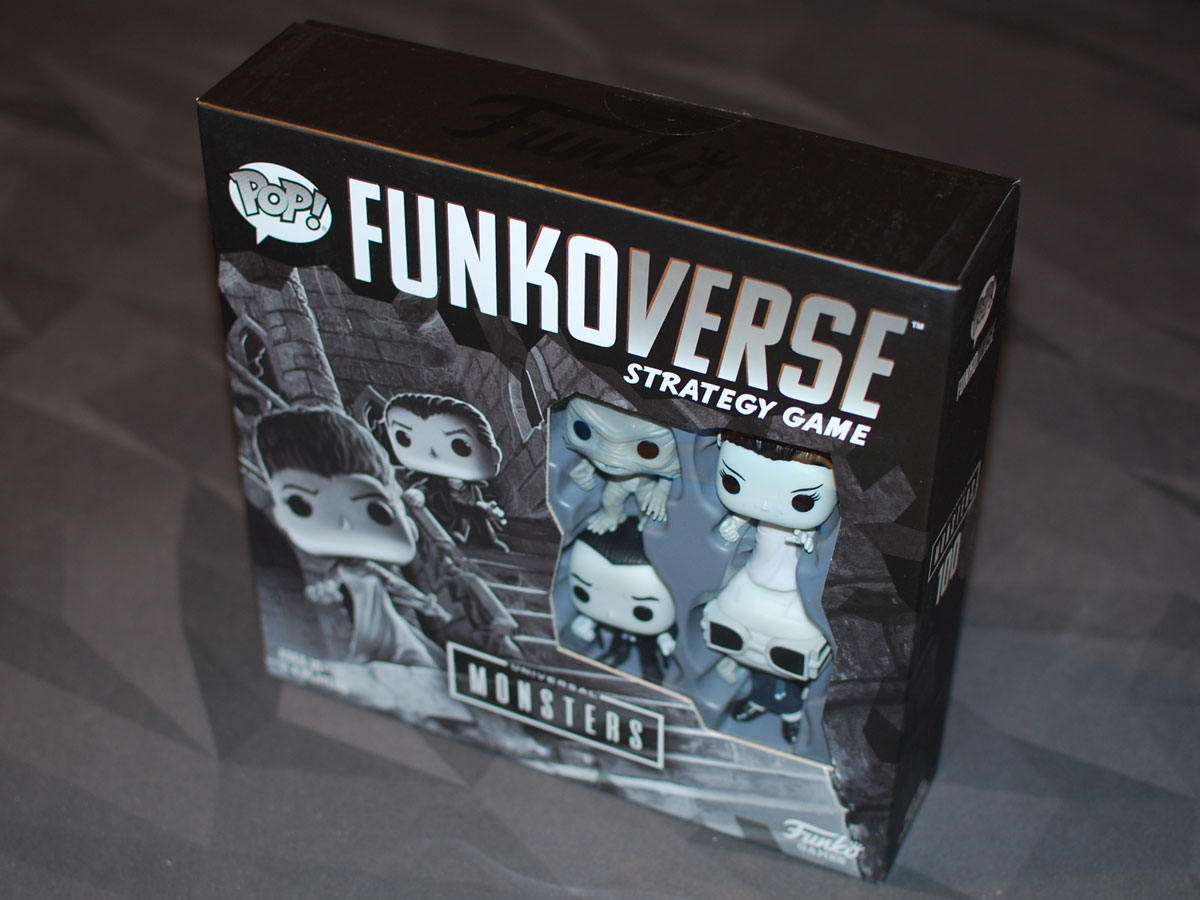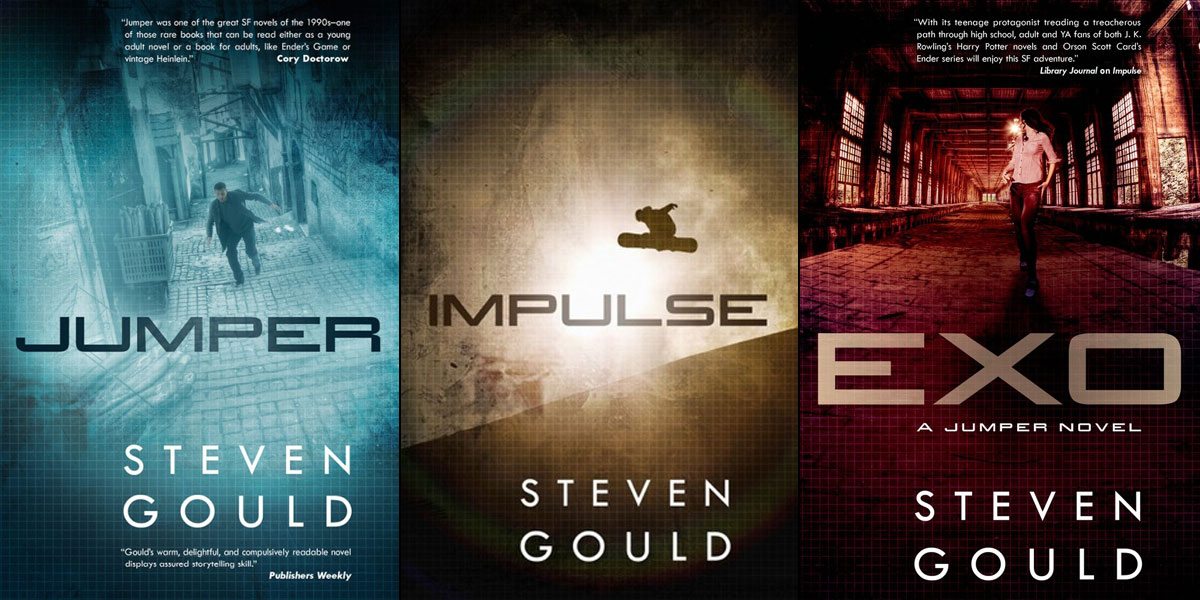Do not adjust your set—this Funkoverse set revives your favorite classic movie monsters, in black and white!
What Is Funkoverse: Universal Monsters?
Funkoverse: Universal Monsters is a tactical strategy game for 2 to 4 players (or up to 6 players with expansions), ages 10 and up, and takes about 20 to 60 minutes to play (depending on the scenario). It retails for $39.99 and is available in stores or online. There are many different Funkoverse sets, each using the same base rules but with different character abilities, and you can mix-and-match them. The gameplay isn’t too complex and I think the 10+ recommendation seems about right.
Funkoverse: Universal Monsters was designed by Prospero Hall (a game design collective) and published by Funko Games.
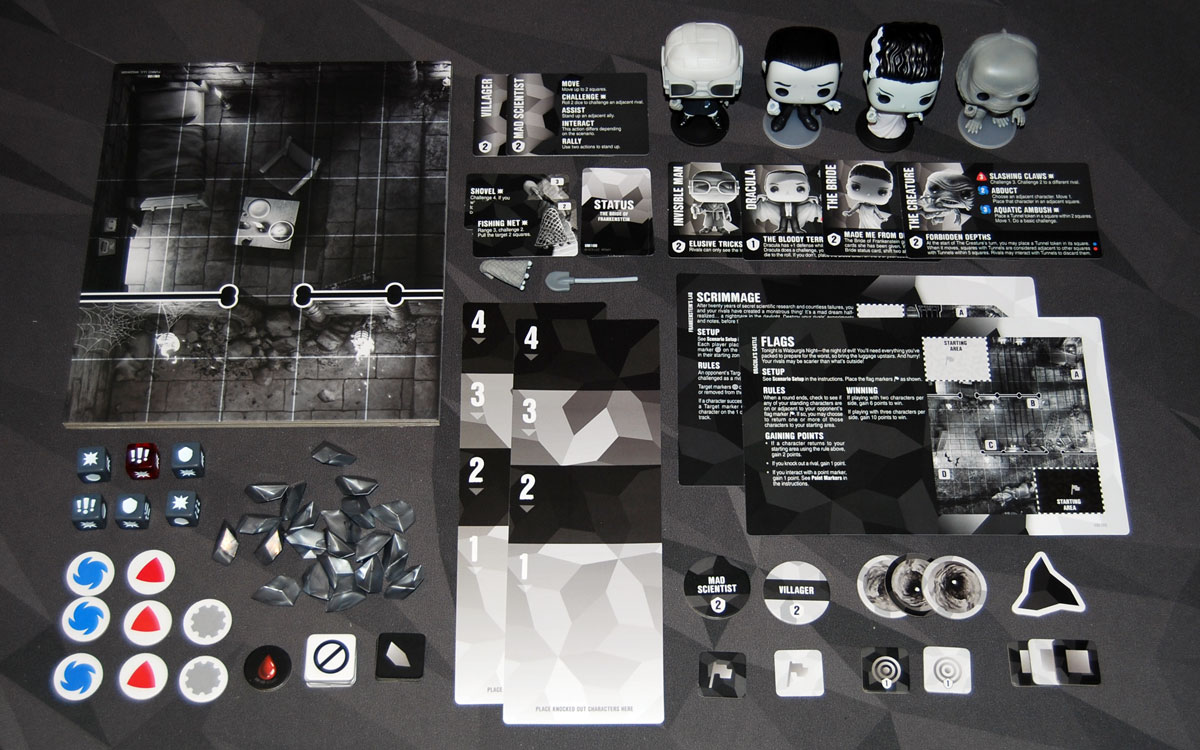
Funkoverse: Universal Monsters Components
In case you’re new to the Funkoverse world, there are three primary types of Funkoverse sets: single-character sets (like Darkwing Duck), 2-character sets, and 4-character sets. In some instances, there’s a large set and a small set in the same world (usually numbered 100 and 101), so that you can combine them for the full 3-vs-3 teams. Most of the sets have a lot of similarities in the types of components included, with some variations based on specific character abilities.
Universal Monsters 100 has 4 characters and is a stand-alone—there isn’t (currently) another set in the same world.
Here’s what comes in the box:
- Game board
- 2 Cooldown tracks
- 2 Scenario cards
- 4 Character figures
- 4 Character cards
- 2 Basic Character cards
- 2 Basic Character tokens
- 2 Item cards
- Shovel
- Fishing Net
- 6 Dice (5 regular, 1 Dracula Blood die)
- 21 Point crystals
- 8 Ability tokens
- Dracula’s Blood token
- 6 Exhausted tokens
- 4 Point tokens
- 3 Tunnel tokens
- First Player marker
- 2 Flag tokens
- 2 Scrimmage tokens
- 3 Control tokens
As you can see from the photos, this set is a throwback to the black-and-white monster movies, and uses a greyscale palette for most of the components, from the figurines themselves to the board to the tokens. A few things are still colored: the ability icons on the cards and corresponding tokens, and a few of Dracula’s blood-themed items in red. It’s a really fun effect, though I’ll admit that it can make some of the tokens a bit harder to spot on the board when everything is in grayscale.
The figurines used for Funkoverse characters are about 3″ tall, smaller than the standard Funko Pop! collectibles you see everywhere, but larger than the Mini Pops. While similar to their counterparts, the Funkoverse characters all have one hand positioned so it can grip an item, as well as a hole in the bottom (usually in the left foot) so that you can swap between the two different colors of plastic bases.

The Universal Monsters includes the Invisible Man, The Bride (of Frankenstein), Dracula, and The Creature (from the Black Lagoon). As you can see, they’re not entirely grayscale and have some hints of color: the Invisible Man’s robe is slightly blue, the Bride’s dress is just a little pink, and the Creature’s skin has a hint of green to it.
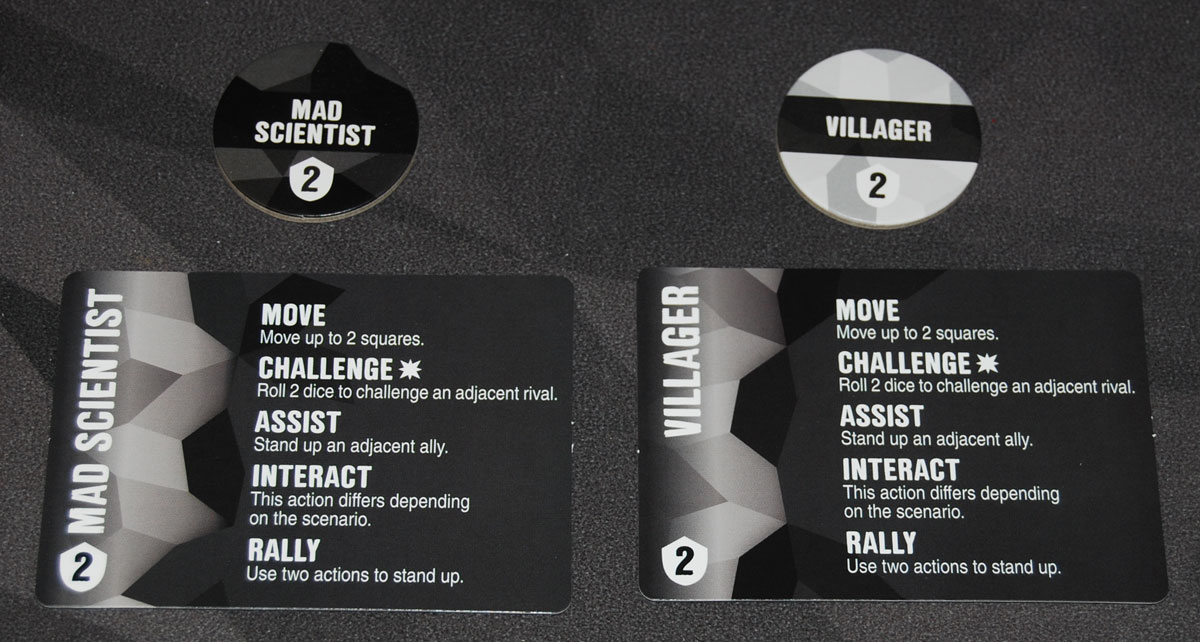
Basic characters are used to fill out the 3-character teams when you don’t have other sets to include. They can only do basic actions instead of special abilities, and are represented by a token rather than a figurine.
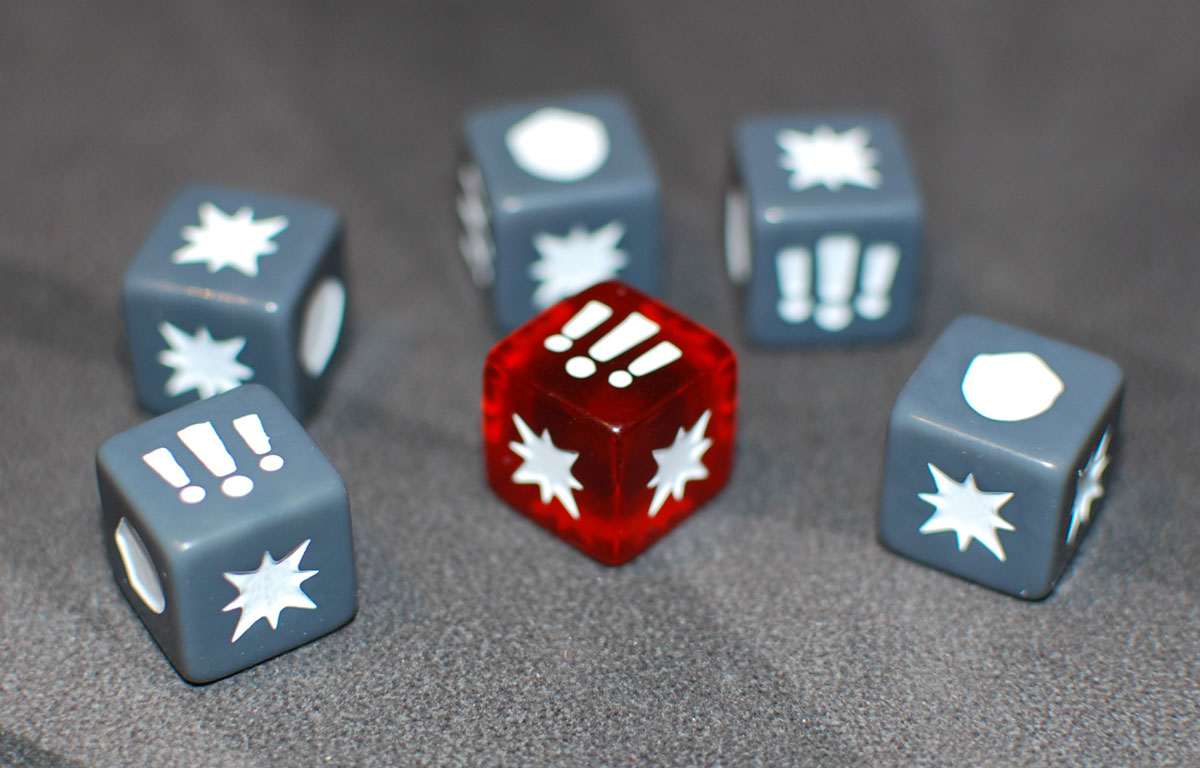
The dice are standard sized, engraved and painted. The grey dice are the same as those found in other sets, with 3 starbursts, 2 shields, and 1 triple-bang on each die. Dracula’s blood die is a translucent red and really stands out in this set; it has 5 starbursts and 1 triple-bang.

Most of the Funkoverse sets I’ve seen include translucent colored crystals of a single color; one exception is the Marvel Thanos set, which has the six Infinity stones as crystals. Universal Monsters uses a pearlescent gray for the crystals—they’re not as boring as flat gray, though perhaps not as exciting as the translucent ones.
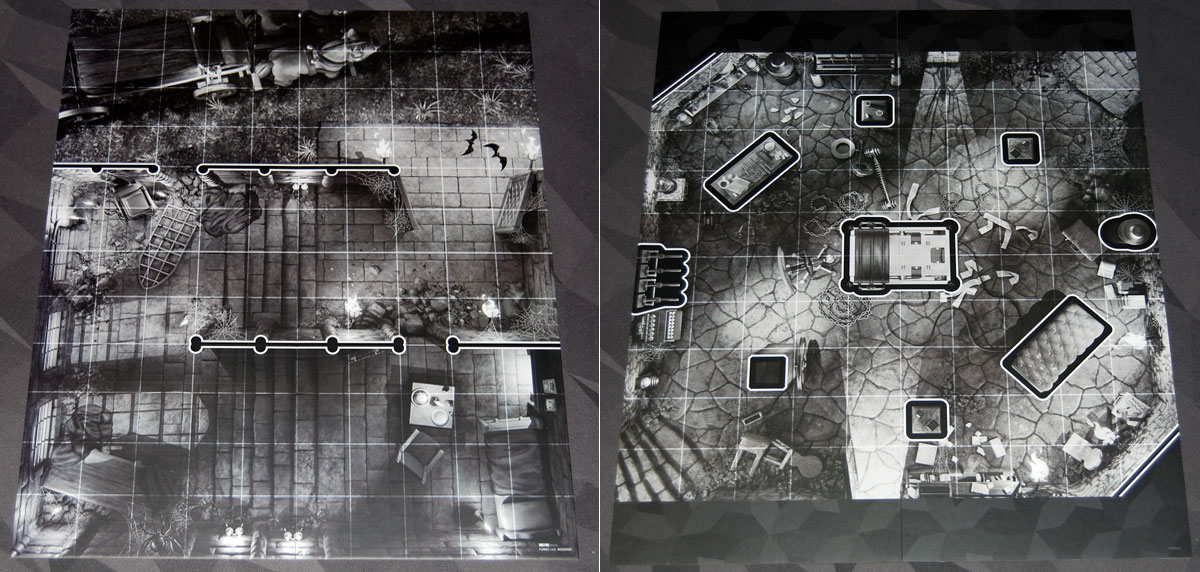
The quad-fold game board has two different maps to play with, Dracula’s castle and Frankenstein’s lab. As with other Funkoverse sets, one map takes up the entire board (a 10×12 grid), and the other is slightly smaller (a 10×10 grid). In the 2-character sets, the board is actually the same size, but is a six-fold board instead to fit in the smaller box.
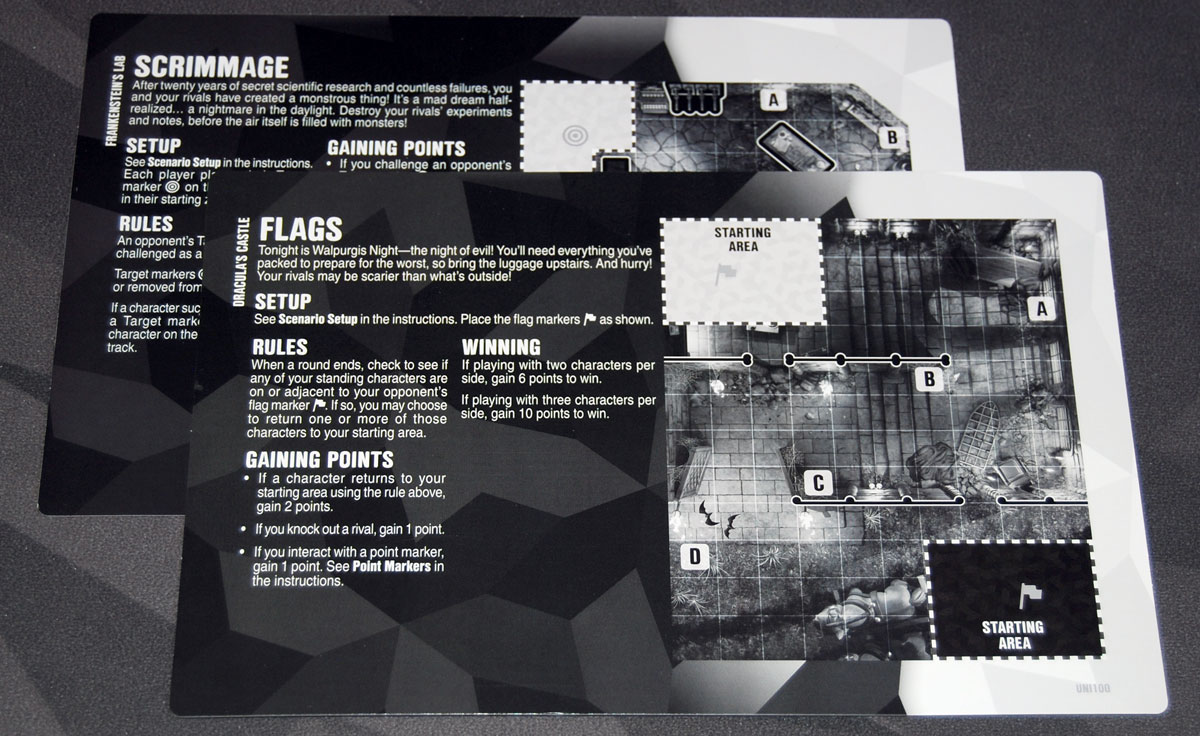
There are two double-sided scenario cards provided, giving setup instructions and additional rules for various modes of play. Most of the sets have fairly similar scenarios, things like capture the flag or controlling particular points or regions, along with a “knock out the leader” scenario. (A few have specialized scenarios, like playing croquet in the Alice in Wonderland set.) Universal Monsters includes Scrimmage, Flag, Control, and Leaders, some of the more basic variants.
How to Play Funkoverse: Universal Monsters
You can download a copy of the rulebook here. There’s also an expanded version of the rules that covers Funkoverse as a whole rather than this specific set. GeekMom Elizabeth MacAndrew goes into more detail on how to play in her review of the Marvel sets, so I’ll try to give a quick overview that skims over the basic concepts.
The Goal
The goal of the game is generally to score a number of points first, though exactly how you score points will depend on the specific scenario.

Setup
You’ll divvy up the characters, giving each team the corresponding character cards, figurines, and any associated components (like Dracula’s blood die and token, or the Bride’s status cards). Affix the bases to the figurines corresponding to their team, and also give each team their basic character. Each team takes 3 exhausted tokens, as well as the ability tokens shown on their character cards.
The scenario card will explain specific setup details, if any tokens need to be placed on the board. Set one cooldown track near each team, and set the crystals and dice nearby. Flip the first player marker to see which team will go first.
Gameplay
On your team’s turn, you choose a character to activate and do two actions, and then place the exhausted marker on the card to indicate that it cannot be chosen until the next round. After all six characters have been activated (and exhausted), the round ends and the exhausted tokens are removed; also, everything on the cooldown tracks is shifted down one space, and the first player marker is flipped over to indicate the other team.
Basic actions include:
- Move 2 spaces.
- Challenge (attack) an adjacent target with 2 dice.
- Assist an adjacent knocked-down ally to stand them up.
- Interact with things—generally this is scenario-specific, like capturing a flag or picking up a point crystal.
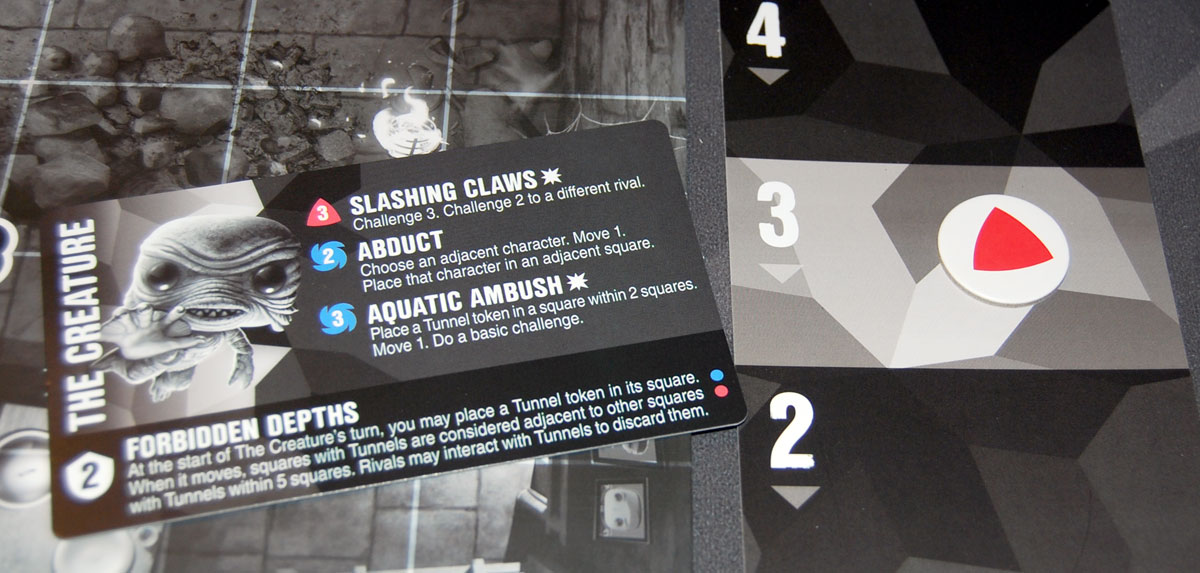
Special actions include:
- Use a character ability by placing an available matching token onto the cooldown track as indicated.
- Use an item if you have one by placing the item card on the cooldown track.
If your character is knocked down, you cannot take regular actions and instead may use both actions to rally, standing up in your current space.
Challenges are how you attack other characters—your basic challenge can only hit characters adjacent to you, but some abilities have range and additional effects. The challenger rolls dice as indicated by the ability, and the defender rolls dice shown on the shield on their character card. Generally speaking, you need to have more successes than your opponent, with ties going to the defender. For the challenger, starbursts count as 1 success and the triple-bang counts as 3 successes. For the target, shields count as 1 success and the triple-bang counts as 3 successes.
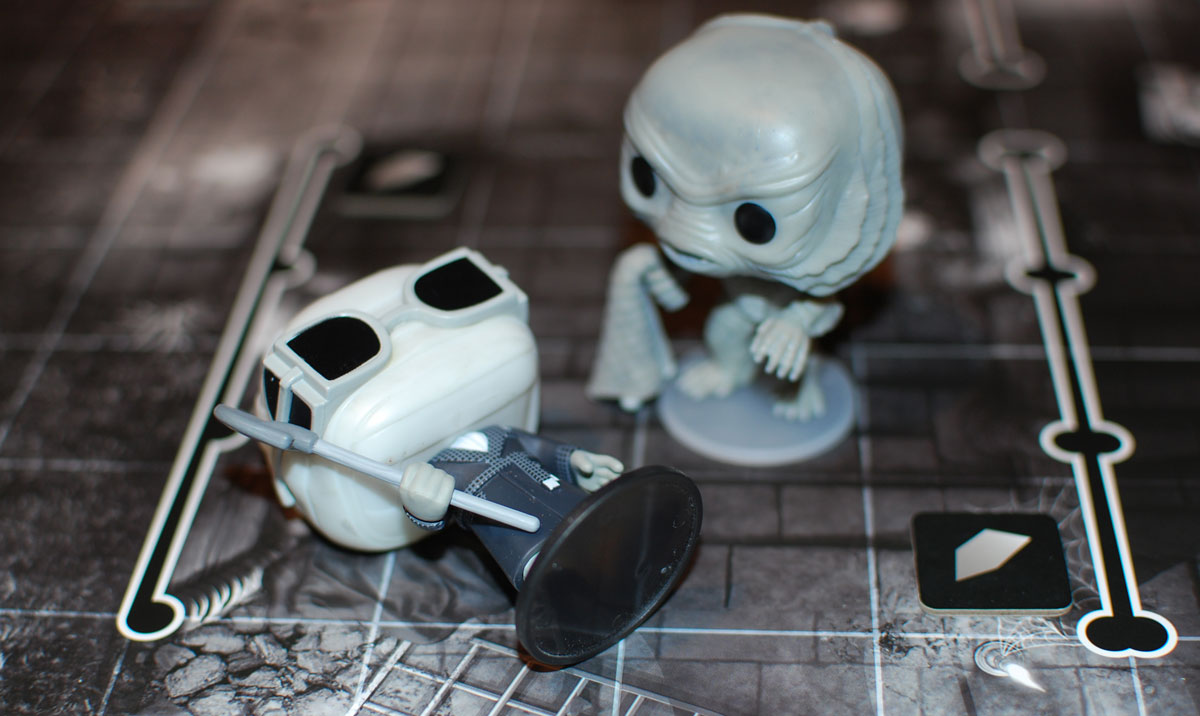
If you successfully challenge a standing rival, they get knocked down. If you successfully challenge a knocked-down rival, they get knocked out and are placed on the “1” space of the cooldown track, and will be returned to play in the next round.
There are some more details about things like how you can move or see around obstacles and which things block line of sight, but that’s the basic idea.

Advanced rules can also include the “attachments” or items: most sets come with one attachment for every two characters. Universal Monsters includes a shovel, which lets you take a big whack at somebody, and then shift things down your cooldown track if you win. The fishing net is a ranged attack that lets you pull the target toward you.
When playing with more than 2 players as teams, you just each take control of specific characters, but you can still activate characters on a team in any order during the round. You can also play a free-for-all game where everyone is your rival.
Game End
The game ends when somebody scores enough points, according to the scenario card.
Why You Should Play Funkoverse: Universal Monsters
The Funkoverse games are a nice introduction to tactical strategy games—you’ve got unique characters with different abilities and a variety of gameplay modes, but they all use the same underlying rules for movement and attacks. It’s a fairly simple system: you get two actions on your turn, and you play until your team has scored enough points.
Where things get interesting is using the character abilities, and that even starts when you pick your teams. Each character contributes a number of tokens to the team’s pool, and then any character on that team can use those tokens if they have matching abilities. There are actually four different token types, though Universal Monsters only includes three of them. Blue is usually for movement and agility; red is strength and fortitude; grey is ingenuity and deception; yellow is leadership and willpower. If you have a powerful red ability (say, Dracula’s “Exsanguinate,”) but your team only has one red token, then you’ll only be able to do that once every four rounds while you wait for it to cool down. But if your team has two red tokens, Dracula could Exsanguinate twice as often (as long as the other characters don’t use their own red abilities in the meantime).
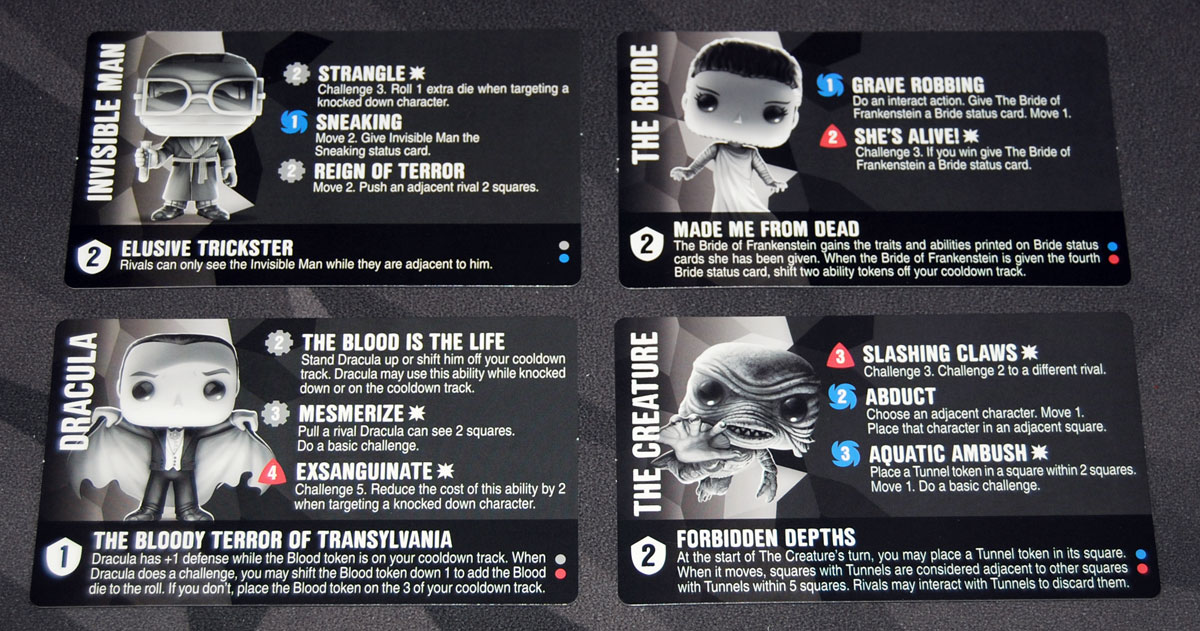
Here’s what these four characters bring to the table:
- The Invisible Man can’t be seen by rivals unless they’re adjacent to him, which means he can’t be targeted by ranged attacks. If he uses his Sneaking ability, he gains a status card that gives him a bonus action if he’s not within a rival’s sight.
- Dracula is able to get back into the fight more quickly when he’s knocked down or knocked out. He uses his blood token to boost challenges, spending it to add his special die to challenges—it’s very good for attacking, but not so great for defending.
- The Bride starts off a bit weaker, but gets stronger as you bring her to life—you start to gain the Bride status cards, which have additional abilities on them (see below).
- The Creature is a hack-and-slash character: it can place tunnels on the board to move more quickly, carry away other characters (either to get your ally out of a bad situation, or drag a rival away from its team).

Each of the Bride’s status cards gives her additional abilities—she’ll be able to stand back up for a low cost, move more quickly, or extend her reach for interacting, assisting, and attacking. This is a fun mechanic that I haven’t seen used in the other sets, and really fits nicely with the theme of finding more parts for the Bride and stitching her together.
One of the things I like about the Funkoverse line of games is the way that you can learn the basic rules once and then you can play with a wide variety of characters with all sorts of different abilities. From what I’ve seen, they do a good job of coming up with thematic powers each character has, as well as giving them fitting names. I haven’t done a lot of mix-and-matching myself yet, but mostly because I’m often still trying out the new characters on their own first. But I do like the idea of pitting Dracula against a velociraptor, or seeing how the Golden Girls fare against Thanos.
Of course, this being Funko, at least a part of the draw of Funkoverse is the collectible figurines. I remember when these were first announced a few years ago, they explained that they needed this third, in-between size because it would work best for games. Clearly the regular size were way too big for a game—you’d need an enormous table for that. But I’m not entirely convinced that the mini Pops wouldn’t have been a good size: in fact, the boxy heads of these figurines can make it hard for too many characters to stand in adjacent squares, and when somebody gets knocked down, they extend into other squares. The primary difference is that they need to be able to hold items and switch bases, so maybe I’ll give them that. Just be warned that if you start buying Funkoverse sets, it may be harder not to fall into a collector’s mentality because of the figurines. But, hey, if you already like Funko Pops and your favorite pop culture property has a Funkoverse game, you may enjoy it both for the strategy game and the toy value!
For more information, visit the Funko Games website.
Click here to see all our tabletop game reviews.
![]() To subscribe to GeekDad’s tabletop gaming coverage, please copy this link and add it to your RSS reader.
To subscribe to GeekDad’s tabletop gaming coverage, please copy this link and add it to your RSS reader.
Disclosure: GeekDad received a copy of this game for review purposes.
